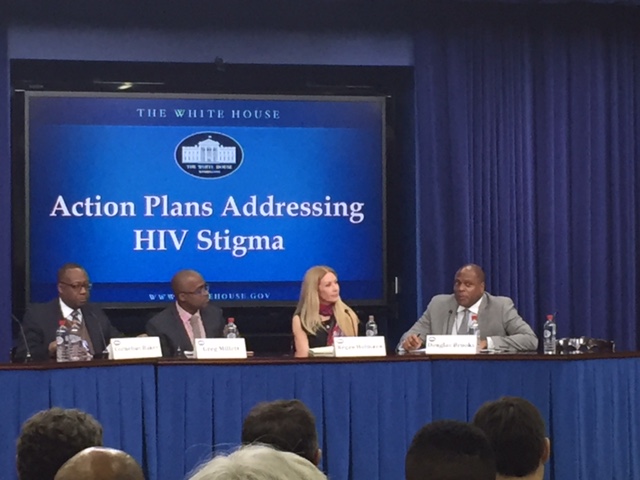
As we approach the 35th anniversary of the first case reports of what would later come to be known as HIV/AIDS, we can rightfully celebrate that we now have an array of effective tools to prevent new infections, diagnose them, and care for people living with HIV. Yet the great effectiveness of these tools is too often blunted due to persistent HIV-related stigma and discrimination. We know from studies as well as countless personal stories that HIV-related stigma inhibits far too many people from accessing HIV prevention, testing, and care, even today. Clearly, in order to end the epidemic, we must combat stigma and discrimination. With that in mind, earlier this month, as part of ongoing work to advance the National HIV/AIDS Strategy, the White House and the National Institutes of Health (NIH) held a meeting specifically focused on what the research tells us about HIV-related stigma and what more we need to know about it.
NIH-supported research has contributed to many tools to measure stigma and development of interventions to prevent it. The March 3 meeting, subtitled “Translating Research to Action: Reducing HIV Stigma to Optimize HIV Outcomes,” was jointly convened by the White House Office of National AIDS Policy (ONAP), the NIH Office of AIDS Research, and the National Institute of Mental Health (NIMH). The gathering brought together researchers and other stakeholders from across the U.S. and around the world including representatives from Federal agencies, leading academic institutions, the legal community, advocates, and ministers for a rich conversation about this complex and multifaceted issue. Participants discussed best practices for measuring and monitoring HIV stigma, as well as methods of intervention focused on reducing or overcoming stigma in order to improve HIV outcomes as well as gaps in our understanding of stigma that need to be examined further.
Among the key points discussed in presentations, panel discussions, and dialogue were the following:
- Stigma is prevalent around the world and remarkably consistent across countries, with many more similarities than differences.
- Stigma can come from friends and family, the larger community, health care providers, and law enforcement as well as be internalized (i.e., self-stigma). Each of these suggests different ways and places for intervention to prevent or reduce stigmatizing behaviors, practices, or policies.
- Providers in the healthcare system, one presenter observed, can sometimes unwittingly be agents of stigma. Even for the most resilient and resourceful person, observed another presenter, interactions with their health care providers can have a profound impact on the individual’s willingness to engage in care. Thus working to ensure that HIV prevention, testing, and care can be delivered in a stigma-free manner is vital to achieving better health outcomes for people living with HIV.
- Measures now exist that enable us to not only understand stigma’s scope and dimensions, but also to design effective programs and evaluate progress. It is important to examine and measure HIV-related stigma experienced by people living with HIV as well as both the general public’s and healthcare providers’ attitudes about HIV to effectively intervene and improve health outcomes for people living with HIV.
- Research has yielded mechanisms to reduce stigma and interventions exist for adaptation and scale-up.
- HIV-related stigma and discrimination are often intertwined with other forms of stigma and discrimination, such as those related to sexual orientation, gender identity, mental health, substance use, sex work, socio-economic status, and/or race/ethnicity.
- Stigma is an under-studied social determinant of health in HIV prevention and care outcome studies.
- HIV-related stigma and rights violations are often inter-related; as such, addressing stigma is as much a human rights issue as an HIV issue.
- Leaders and stakeholders from many sectors must be engaged in addressing stigma and stopping discrimination. Participants highlighted roles for health care providers, policy makers, faith communities, community members, people living with HIV, and researchers.
- While goals, measures, and interventions to reduce stigma are vital, several presenters shared a profound belief that through telling and listening to personal stories we help others better understand and, ultimately, address stigma. Speaking during the first panel, my predecessor Douglas Brooks, UNAIDS’ Regan Hofmann, and PEPFAR’s Cornelius Baker each shared compelling examples of HIV-related stigma they had experienced. Two examples of how personal stories have been shared by the Federal government include the moving personal story shared prior to the meeting by our colleague Dr. Richard Wolitski and CDC’s Let’s Stop HIV Together campaign.
The meeting galvanized the participating researchers and other stakeholders and will hopefully lead to new insights, collaborative efforts, and utilization of evidence-based measures and interventions The information shared during the meeting will also aid the ongoing efforts of NIMH, which views stigma as a significant component of all the new NIH AIDS research funding priorities and will continue to place a high priority on stigma research in the years ahead. The information will also be utilized by ONAP as we continue work with Federal partners and other stakeholders to develop an NHAS indicator to measure stigma. We hope that these collective efforts along with those by other stakeholders will accelerate the reduction of HIV-related stigma and improve outcomes for people living with HIV.
Amy Lansky, PhD, MPH is the Acting Director of the Office of National AIDS Policy.


